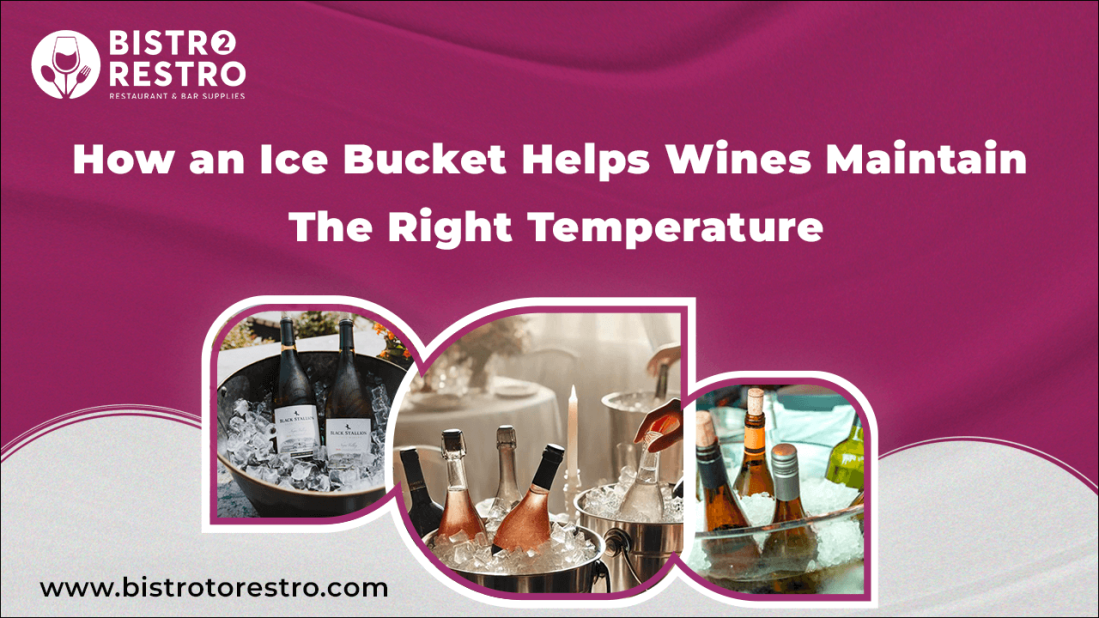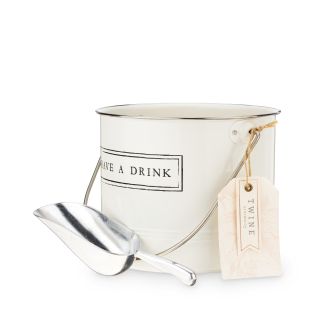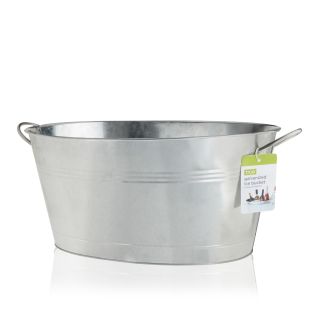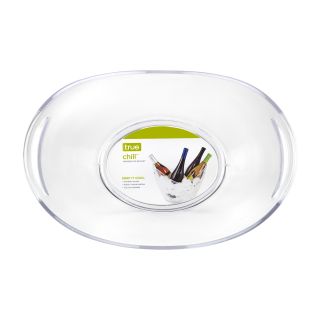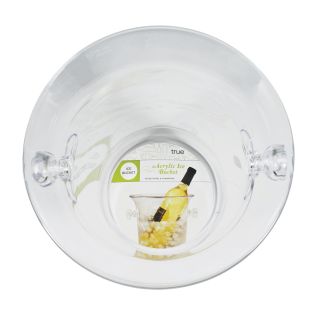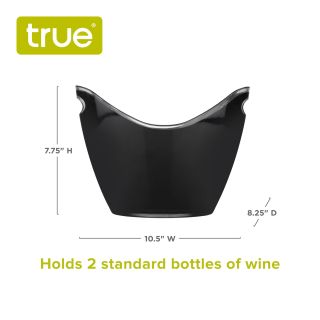Serving wine at the correct temperature is essential to fully enjoy its flavor, aroma, and character. Whether you're pouring a crisp white or a light-bodied red, temperature can significantly impact the overall tasting experience. One of the simplest and most effective tools for maintaining ideal wine temperature is an ice bucket. Often used in both casual and formal settings, an ice bucket helps keep wine chilled and consistent, especially when served over an extended period. By regulating temperature, it ensures that each glass offers the wine's intended profile. In this article, we’ll explore how an ice bucket works to preserve wine quality and why it should be a staple accessory for anyone who appreciates a perfectly served bottle.
The Importance of Serving Wine at the Correct Temperature
Serving wine at the correct temperature is crucial for enhancing its flavor, aroma, and overall enjoyment. Temperature affects how wine expresses its character, and even a small variation can alter the tasting experience.
Why Temperature Matters:
Too Warm: Increases alcohol perception and dulls subtle flavors.
Too Cold: Suppresses aromas and mutes the wine’s complexity.
Ideal Serving Temperatures by Wine Type:
White Wines: Best served chilled at 45°F–55°F (7°C–13°C), enhances crispness and bright acidity.
Red Wines: Ideal between 55°F–65°F (13°C–18°C) brings out tannins, complexity, and structure.
Sparkling Wines: Served at 40°F–50°F (4°C–10°C) maintains carbonation and freshness.
Rosé Wine: Rosé wines are typically served chilled, around 45°F to 55°F (7°C to 13°C), similar to white wines, to keep their refreshing and vibrant nature intact.
Practical Ways to Maintain Temperature:
Ice Buckets: Quick, efficient, and easy to use during service.
Wine Fridges: Ideal for precise long-term storage and chilling.
Cooling Sleeves: Portable and great for outdoor or mobile service.
Maintaining the proper wine temperature ensures a balanced and full sensory experience, whether you're serving in a restaurant, tasting room, or at home.
Check out our article on essential liquors and mixers to stock at your bar for more tips on creating the perfect drinking experience.
How an Ice Bucket Works to Cool Wine
An ice bucket is a simple yet effective tool used to quickly chill wine and maintain the ideal serving temperature. It works based on conductive cooling, where heat from the warmer wine bottle transfers to the colder ice and water mixture. Here's how it works:
Rapid Thermal Cooling: When a wine bottle is placed in the ice bucket, the cold mixture of ice and water absorbs the heat from the bottle. This transfers the heat from the wine into the ice-water, cooling the wine faster.
Cooling Efficiency: Water is essential in the process, as it fills the gaps between the ice cubes, increasing the surface area in contact with the bottle. This maximizes cooling efficiency.
Optimal Temperature: The ice-water mixture is typically at 32°F (0°C), significantly colder than room temperature, ensuring rapid and efficient cooling of the wine.
Fast Cooling: Wine chills in about 20-30 minutes, which is ideal for wines like whites or sparkling wines that need to be served at a specific temperature.
Long-Lasting Effect: Keeping the bottle in the bucket allows the wine to stay cool for a longer period, perfect for maintaining the right temperature during a meal or gathering.
Perfect for Outdoor Settings: Ice buckets are especially useful in warm environments, keeping wine cool during outdoor events, meals, or parties.
This process ensures that your wine is always at the perfect temperature for enjoying.
Benefits of Using an Ice Bucket Over Refrigeration
Using an ice bucket to chill wine offers several advantages over refrigeration, especially when you need to cool a bottle quickly or maintain its ideal serving temperature. Here are some key benefits:
Quick and Efficient Cooling: An ice bucket rapidly chills wine, reaching the desired temperature in as little as 15–20 minutes. The combination of ice and water provides more efficient cooling compared to air inside a refrigerator, making it ideal for last-minute service.
Portable and Convenient for Events: Unlike a refrigerator, an ice bucket is portable. It allows servers or guests to keep the wine cool while dining, reducing the need to move back and forth to the kitchen. This is particularly useful in restaurants or outdoor settings where wines are served at the table.
Consistent Temperature: Ice buckets provide consistent cooling throughout the service, preventing the wine from fluctuating in temperature, unlike a refrigerator, where the temperature can vary due to frequent door openings. With an ice bucket, the wine remains at a stable, chilled temperature during consumption.
Ideal for Outdoor Gatherings and Parties: An ice bucket is perfect for outdoor gatherings and parties, keeping wine cool without the need for a refrigerator. Its portability ensures that your wine stays at the ideal temperature wherever the event takes place.
Best Practices for Using an Ice Bucket
Using an ice bucket effectively ensures that your wine remains at the optimal temperature throughout service. To get the best results, follow these key practices:
Don’t Overfill the Bucket: While it’s important to have enough ice to surround the bottle, overfilling the bucket can lead to inefficient cooling. Aim for enough ice and water to completely submerge the wine bottle without excessive overflow.
Monitor Wine Temperature: Depending on the type of wine, it may need to be removed from the ice bucket sooner than others. Sparkling wines and whites typically need around 20-30 minutes, while reds should be checked after 10-15 minutes.
Place the Bucket in a Cool Spot: If the surroundings are too warm, the ice will melt quickly. Consider placing the ice bucket in a shaded area or in a cool space to prolong the cooling effect.
Refill Ice to Maintain Chill: If you're serving wine for an extended period, periodically add more ice to the bucket to maintain the wine’s ideal temperature.
Mix Ice and Water for Faster Cooling: For optimal cooling, fill the ice bucket with both ice and water. The water helps fill the gaps between the ice cubes, creating more surface contact with the wine bottle. This significantly speeds up the cooling process compared to using ice alone.
Choosing the Right Ice Bucket for Wine
Selecting the right ice bucket for wine is essential for effective cooling and convenience. Here are some factors to consider when choosing the perfect ice bucket:
Size and Capacity: Choose an ice bucket large enough to comfortably fit the wine bottle, leaving room for plenty of ice and water. A bucket that’s too small may not provide adequate cooling, while one that’s too large can be inefficient.
Material: Ice buckets come in a variety of materials, including stainless steel, acrylic, glass, and copper. Stainless steel is a popular choice because it’s durable, keeps the ice colder for longer, and has a sleek, modern look. Acrylic is lightweight and more affordable, but may not have the same insulating properties.
Insulation: Look for an ice bucket with good insulation to keep the ice from melting too quickly. Double-walled or insulated models are great for maintaining a consistent, cold temperature for a longer time.
Design and Aesthetics: Consider the style of the ice bucket to match the setting or occasion. Whether you want something elegant and sophisticated or casual and fun, the design should complement your event.
Ease of Cleaning: Choose an ice bucket that's easy to clean, such as stainless steel or acrylic, which require minimal maintenance. A simple design or removable liner can make cleaning more convenient.
Check out this exciting wine trends for commercial bars to elevate your bar’s presentation and customer experience.
An ice bucket is more than just a simple tool—it’s a wine accessory that can enhance your overall experience by keeping your wine at the ideal temperature. Whether you’re hosting a dinner party or enjoying a bottle by yourself, using an ice bucket ensures that your wine tastes its best, preserving its unique flavors and aromas. By understanding how an ice bucket works, the benefits of using it over refrigeration, and how to choose the right one, you’ll be well-equipped to elevate your wine-drinking experience. So, the next time you open a bottle of wine, make sure you’ve got an ice bucket on hand to ensure it's served just right. Cheers!
Looking for the perfect way to keep your wine at the ideal temperature? At BistroToRestro, we offer premium wine accessories from top brands like True, Twine, and Viski. Find high-quality ice buckets, wine chillers, wine pourers, and bottle stoppers to enhance your wine experience and ensure every pour is perfectly chilled.
FAQs
Why is an ice bucket or wine cooler used in the service of wine?
Ice buckets allow for direct contact between the ice and the bottle, enabling faster cooling of drinks.
Why add salt to an ice bucket?
Remember to add a good amount of water as well as ice, and also a little salt lowers the freezing point of the water to make the ice melt faster and chill your drink quicker
How long does it take to chill wine in an ice bucket?
Chilling wine in an ice bucket generally takes between 10 and 20 minutes, depending on factors like the wine's initial temperature and whether you're using a salted ice bath.
What makes a good ice bucket?
Insulation is a key factor in how well an ice bucket performs, directly impacting how long your drinks stay cold. Insulated ice buckets are designed to slow down the melting of ice by creating a barrier between the ice and the surrounding temperature.

